Fiber Bragg Grating Dilatometry in Extreme Magnetic Field and Cryogenic Conditions
Abstract
:1. Introduction
2. Materials and Methods
2.1. Fast (Millisecond Time Scale) FBG Interrogation Using Swept-Wavelength Lasers
2.2. Very Fast (Microsecond Time Scale) FBG Interrogation Using Broadband Light and a Line Array Camera
2.3. Ultrafast (Nanosecond Time Scale) FBG Interrogation Using Pulsed Lasers
3. A Review of Selected Recent Results
3.1. Magnetostriction Superstructure in the Frustrated Quantum Spin System SrCu2(BO3)2
3.2. Transverse Magnetostriction
3.3. Quantum Oscillations in the Magnetostriction of Metals
3.4. Spin Transitions in the 100 T Range in LaCoO3
4. Experimental Challenges, Artifacts, and Strategies Used to Address Them
4.1. Temperature Effects
4.2. Magnetic Forces
4.3. Artifacts Due to Magnetic Field-Induced Faraday Rotation in the Optical Fiber
4.4. Strain Measurements on Small Samples
4.5. Impact of FBG Length on ΔL/L Sensitivity
5. Conclusions
Acknowledgments
Author Contributions
Conflicts of Interest
References
- Application of Fiber Optic Sensors in Engineering Mechanics; Ansari, F. (Ed.) ASCE SP: Reston, VA, USA, 1993; pp. 1–300. [Google Scholar]
- Othonos, A. Fiber Bragg Gratings. Rev. Sci. Instrum. 1997, 68, 4309–4341. [Google Scholar] [CrossRef]
- Kersey, A.D.; Davis, M.A.; Patrick, H.J.; LeBlanc, M.; Koo, K.P.; Askins, C.G.; Putnam, M.A.; Friebele, E.J. Fiber Grating Sensors. J. Lightwave Technol. 1997, 15, 1442–1463. [Google Scholar] [CrossRef]
- Kreuzer, M. Strain Measurement with Fiber Bragg Grating Sensors; White Paper; HBM GmbH: Darmstadt, Germany, 2006. [Google Scholar]
- Latkaa, I.; Eckea, W.; Höfera, B.; Habisreuther, T.; Kallmeyerb, J.P. Fiber Bragg grating based measurement of elastic properties at cryogenic temperatures. Proc. SPIE 2017, 6770, 677004. [Google Scholar]
- Daou, R.; Weickert, F.; Nicklas, M.; Steglich, F.; Haase, A.; Doerr, M. High resolution magnetostriction measurements in pulsed magnetic fields using fiber Bragg gratings. Rev. Sci. Instrum. 2010, 81, 033909. [Google Scholar] [CrossRef] [PubMed]
- Doerr, M.; Haase, A.; Loewenhaupt, M.; Rotter, M.; Bartkowiak, M.; Daou, R.; Kampert, E.; Perenboom, J.A.A.J.; Tsutaoka, T. Competition of two-ion and single-ion anisotropy in rare-earth systems: Large anisotropy example of Tb5Ge3. Phys. Rev. B 2010, 82, 024422. [Google Scholar] [CrossRef]
- Andreev, A.V.; Skourski, Y.; Kuz’min, M.D.; Yasin, S.; Zherlitsyn, S.; Daou, R.; Wosnitza, J.; Iwasa, A.; Kondo, A.; Matsuo, A.; et al. Magnetic and magnetoelastic anomalies of an Er2Co17 single crystal in high magnetic fields. Phys. Rev. B 2011, 83, 184422. [Google Scholar] [CrossRef]
- Daou, R.; Haase, A.; Doerr, M.; Rotter, M.; Weickert, F.; Nicklas, M.; Steglich, F. Magnetoelastic quantum oscillations in GdSb to 55 T. J. Phys. Conf. Ser. 2011, 273, 012111. [Google Scholar] [CrossRef]
- Altarawneh, M.M.; Chern, G.W.; Harrison, N.; Batista, C.D.; Uchida, A.; Jaime, M.; Rickel, D.G.; Crooker, S.A.; Mielke, C.H.; Betts, J.B.; et al. Cascade of Magnetic Field Induced Spin Transitions in LaCoO3. Phys. Rev. Lett. 2012, 109, 037201. [Google Scholar] [CrossRef] [PubMed]
- Jaime, M.; Daou, R.; Crooker, S.A.; Weickert, F.; Uchida, A.; Feiguin, A.E.; Batista, C.D.; Dabkowska, H.A.; Gaulin, B.D. Magnetostriction and magnetic texture to 100.75 Tesla in frustrated SrCu2(BO3)2. Proc. Natl. Acad. Sci. USA 2012, 109, 12404–12407. [Google Scholar] [CrossRef]
- Kohama, Y.; Wang, S.; Uchida, A.; Prsa, K.; Zvyagin, S.; Skourski, Y.; McDonald, R.D.; Balicas, L.; Ronnow, H.M.; Ruegg, C.; et al. Anisotropic Cascade of Field-Induced Phase Transitions in the Frustrated Spin-Ladder System BiCu2PO6. Phys. Rev. Lett. 2012, 109, 167204. [Google Scholar] [CrossRef] [PubMed]
- Kim, J.W.; Kamiya, Y.; Mun, E.D.; Jaime, M.; Harrison, N.; Thompson, J.D.; Kiryukhin, V.; Yi, H.T.; Oh, Y.; Cheong, S.W.; et al. Multiferroicity with coexisting isotropic and anisotropic spins in Ca3Co2−xMnxO6. Phys. Rev. B 2014, 92, 060404. [Google Scholar] [CrossRef]
- Rotter, M.; Wang, Z.S.; Boothroyd, A.T.; Prabhakaran, D.; Tanaka, A.; Doerr, M. Mechanism of spin crossover in LaCoO3 resolved by shape magnetostriction in pulsed magnetic fields. Nat. Sci. Rep. 2014, 4, 7003. [Google Scholar] [CrossRef] [PubMed]
- Radtke, G.; Saul, A.; Dabkowska, H.A.; Salamon, M.B.; Jaime, M. Magnetic Nanopantograph in the SrCu2(BO3)2 Shastry-Sutherland Lattice. Proc. Natl. Acad. Sci. USA 2015, 112, 1971–1976. [Google Scholar] [CrossRef] [PubMed]
- Rodriguez, G.; Jaime, M.; Mielke, C.H.; Balakirev, F.F.; Azad, A.; Sandberg, R.L.; Marshall, B.; La Lone, B.M.; Henson, B.F.; Smilowitz, L.; et al. Insight into fiber Bragg sensor response at 100 MHz interrogation rates under various dynamic loading conditions. In Fiber Optic Sensors and Applications XII; Book Series: Proceedings of SPIE; Pickrell, G., Udd, E., Du, H.H., Eds.; SPIE: Bellingham, WA, USA, 2015; Volume 9480, p. 948004. [Google Scholar]
- Rodriguez, G.; Jaime, M.; Balakirev, F.; Mielke, C.H.; Azad, A.; Marshall, B.; La Lone, B.M.; Henson, B.; Smilowitz, L. Coherent pulse interrogation system for fiber Bragg grating sensing of strain and pressure in dynamic extremes of materials. Opt. Express 2015, 23, 14219–14233. [Google Scholar] [CrossRef] [PubMed]
- Kim, J.W.; Artyukhin, S.; Mun, E.D.; Jaime, M.; Harrison, N.; Hansen, A.; Yang, J.J.; Oh, Y.S.; Vanderbilt, D.; Zapf, V.S.; et al. Successive Magnetic-Field-Induced Transitions and Colossal Magnetoelectric Effect in Ni3TeO6. Phys. Rev. Lett. 2015, 115, 137201. [Google Scholar] [CrossRef] [PubMed]
- Weickert, F.; Harrison, N.; Scott, B.L.; Jaime, M.; Leitmae, A.; Heinmaa, I.; Stern, R.; Janson, O.; Berger, H.; Rosner, H.; et al. Magnetic anisotropy in the frustrated spin-chain compound β-TeVO4. Phys. Rev. B 2016, 94, 064403. [Google Scholar] [CrossRef]
- Okada, M.; Tanaka, H.; Kurita, N.; Johmoto, K.; Uekusa, H.; Miyake, A.; Tokunaga, M.; Nishimoto, S.; Nakamura, M.; Jaime, M.; et al. Quasi-two-dimensional Bose-Einstein condensation of spin triplets in the dimerized quantum magnet Ba2CuSi2O6Cl2. Phys. Rev. B 2016, 94, 094421. [Google Scholar] [CrossRef]
- Stillwell, R.L.; Liu, I.-L.; Harrison, N.; Jaime, M.; Jeffries, J.R.; Butch, N.P. Tricritical point of the f-electron antiferromagnet USb2 driven by high magnetic fields. Phys. Rev. B 2017, 95, 014414. [Google Scholar] [CrossRef]
- Grachtrup, D.S.; Steinki, N.; Sullow, S.; Cakir, Z.; Zwicknagl, G.; Krupko, Y.; Sheikin, I.; Jaime, M.; Mydosh, J.A. Magnetic phase diagram and electronic structure of UPt2Si2 at high magnetic fields: A possible field-induced Lifshitz transition. Phys. Rev. B 2017, 95, 134422. [Google Scholar] [CrossRef]
- Jaime, M.; Saul, A.; Salamon, M.; Zapf, V.S.; Harrison, N.; Durakiewicz, T.; Lashley, J.C.; Andersson, D.A.; Stanek, C.R.; Smith, J.L.; et al. Piezomagnetism and magnetoelastic memory in uranium dioxide. Nat. Commun. 2017, 8, 99. [Google Scholar] [CrossRef] [PubMed]
- Shrestha, K.; Antonio, D.; Jaime, M.; Harrison, N.; Mast, D.S.; Safarik, D.; Durakiewicz, T.; Griveau, J.C.; Gofryk, K. Tricritical point from high-field magnetoelastic and metamagnetic effects in UN. Nat. Sci. Rep. 2017, 7, 6642. [Google Scholar] [CrossRef] [PubMed]
- Ronning, F.; Helm, T.; Hirer, K.R.S.; Bachmann, M.D.; Balicas, L.; Chan, M.K.; Ramshaw, B.J.; McDonald, R.D.; Balakirev, F.F.; Jaime, M.; et al. Electronic in-plane symmetry breaking at field-tuned quantum criticality in CeRhIn5. Nature 2017, 548, 7667. [Google Scholar] [CrossRef] [PubMed]
- Zavareh, M.G.; Skourski, Y.; Skokov, K.P.; Karpenkov, D.Y.; Zvyagina, L.; Waske, A.; Haskel, D.; Zhernenkov, M.; Wosnitza, J.; Gutfleisch, O. Direct Measurement of the Magnetocaloric Effect in La(Fe,Si,Co)13. Compounds in Pulsed Magnetic Fields. Phys. Rev. Appl. 2017, 8, 014037. [Google Scholar] [CrossRef]
- Rosa, P.F.S.; Thomas, S.M.; Balakirev, F.F.; Betts, J.; Seo, S.; Ronning, F.; Bauer, E.D.; Thompson, J.D.; Jaime, M. An FBG optical approach to thermal expansion measurements under hydrostatic pressure. Sensors 2017, 17, 2543. [Google Scholar] [CrossRef]
- Kim, J.W.; Mun, E.D.; Ding, X.; Hansen, A.; Jaime, M.; Harrison, N.; Yi, H.T.; Chai, Y.; Sun, Y.; Cheong, S.W.; et al. Metastable states in frustrated triangular compounds Ca3Co2−x MnxO6 and Ca3Co2O6. Phys. Rev. B 2017. under review. [Google Scholar]
- Wartenbe, M.; Harrison, N.; Boebinger, G.S.; Baumbach, R.; Salamon, M.B.; Jaime, M. Magnetostriction and octupolar order in URu2Si2. 2017; in preparation. [Google Scholar]
- Jaime, M.; Thirunavukkuarasu, K.; Smirnov, D.; Lu, Z.; Christianen, P.; Ballotin, M.; Dabkowska, H.; Radtke, G.; Saul, A. Raman Scattering and Dilatometry of Frustrated Spin Dimer Compound SrCu2(BO3)2 in High Magnetic Fields to 45T. 2017; in preparation. [Google Scholar]
- Schmiedeshoff, G.M.; Lounsbury, A.W.; Luna, D.J.; Tracy, S.J.; Schramm, A.J. Versatile and compact capacitive dilatometer. Rev. Sci. Instrum. 2006, 77, 123907. [Google Scholar] [CrossRef]
- Küchler, R.; Stingl, C.; Gegenwart, P. A uniaxial stress capacitive dilatometer for high-resolution thermal expansion and magnetostriction under multiextreme conditions. Rev. Sci. Instrum. 2016, 87, 073903. [Google Scholar] [CrossRef] [PubMed]
- Küchler, R.; Bauer, T.; Brando, M.; Steglich, F. A compact and miniaturized high resolution capacitive dilatometer for measuring thermal expansion and magnetostriction. Rev. Sci. Instrum. 2012, 83, 095102. [Google Scholar] [CrossRef] [PubMed]
- Doerr, M.; Lorenz, W.; Neupert, T.; Loewenhaupt, M.; Kozlova, N.V.; Freudenberger, J.; Bartkowiak, M.; Kampert, E.; Rotter, M. Simultaneous measurement of magnetization and magnetostriction in 50 T pulsed k magnetic fields. Rev. Sci. Instrum. 2008, 79, 063902. [Google Scholar] [CrossRef] [PubMed]
- Bozorth, R.M.; Hamming, R.W. Measurement of Magnetostriction in Single Crystals. Phys. Rev. 1953, 89, 865. [Google Scholar] [CrossRef]
- Levitin, R.Z.; Milov, V.N.; Popov, Y.F.; Snegirev, V.V. Magnetostriction measurements under high magnetic fields by a piezoelectric transducer glued on the sample. Phys. B 1992, 177, 59–62. [Google Scholar] [CrossRef]
- Park, J.H.; Graf, D.; Murphy, T.P.; Schmiedeshoff, G.M.; Tozer, S.W. High resolution miniature dilatometer based on an atomic force microscope piezocantilever. Rev. Sci. Instrum. 2009, 80, 116101. [Google Scholar] [CrossRef] [PubMed]
- Schillig, J.; Boenig, H.; Gordon, M.; Mielke, C.; Rickel, D.; Sims, J.; Martin, J.; Williams, R. Operating experience of the United States National High Magnetic Field Laboratory 60 T Long Pulse magnet. IEEE Trans. Appl. Supercond. 2000, 10, 526–529. [Google Scholar] [CrossRef]
- Sims, J.; Baca, A.; Boebinger, G.; Boenig, H.; Coe, H.; Kihara, K.; Manzo, M.; Mielke, C.; Schillig, J.; Eyssa, Y.; et al. First 100 T non-destructive magnet. IEEE Trans. Appl. Supercond. 2000, 10, 510–513. [Google Scholar] [CrossRef]
- Bird, M.D.; Bole, S.; Dixon, I.; Eyssa, Y.M.; Gao, B.J.; Schneider-Muntau, H.J. The 45 T hybrid insert: Recent achievements. Phys. B Condens. Matter 2001, 294–295, 639–664. [Google Scholar] [CrossRef]
- Singleton, J.; Mielke, C.H.; Migliori, A.; Boebinger, G.S.; Lacerda, A.H. The national high magnetic field laboratory pulsed-field facility at Los Alamos National Laboratory. Phys. B Condens. Matter 2004, 346, 614–617. [Google Scholar] [CrossRef]
- Mielke, C.H.; McDonald, R.D. Single turn multi-megagauss system at the NHMFL-Los Alamos to study plutonium. In Proceedings of the International Conference on Megagauss Magnetic Field Generation and Related Topics, Herlany, Slovakia, 5–10 November 2006; pp. 227–231. [Google Scholar]
- Rodriguez, G.; Smilowitz, L.; Henson, B.F. Embedded fiber Bragg grating pressure measurement during thermal ignition of a high explosive. Appl. Phys. Lett. 2016, 109, 164101. [Google Scholar] [CrossRef]
- Ikeda, A.; Nomura, T.; Matsuda, Y.H.; Tani, S.; Kobayashi, Y.; Watanabe, H.; Sato, K. High-speed 100 MHz strain monitor using fiber Bragg grating and optical filter for magnetostriction measurements under ultrahigh magnetic fields. Rev. Sci. Instrum. 2017, 88, 083906. [Google Scholar] [CrossRef] [PubMed]
- Harasim, D. The influence of fibre bending on polarization-dependent twist sensor based on tilted brag grating. Metrol. Meas. Syst. 2017, 24, 577–584. [Google Scholar] [CrossRef]
- Caucheteur, C.; Guo, T.; Albert, J. Polarization-assisted fiber Bragg grating sensors: Tutorial and review. J. Lightwave Technol. 2017, 35, 3311–3322. [Google Scholar] [CrossRef]
- Chandrasekhar, B.S. A note on the possibility of observing de Haas-Van Alphen oscillations in magnetostriction. Phys. Lett. 1963, 6, 27–28. [Google Scholar] [CrossRef]
- Ansari, F.; Libo, Y. Mechanics of bond and interface shear transfer in optical fiber sensors. J. Eng. Mech. 1998, 124, 385–394. [Google Scholar] [CrossRef]
- Wan, K.T.; Leung, C.K.Y.; Olson, N.G. Investigation of the strain transfer for surface-attached optical fiber strain sensors. Smart Mater. Struct. 2008, 17, 035037. [Google Scholar] [CrossRef]
- Her, S.-C.; Huang, C.-Y. Effect of coating on the strain transfer of optical fiber sensors. Sensors 2011, 11, 6926–6941. [Google Scholar] [CrossRef] [PubMed]
- Li, D.; Ren, L.; Li, H. Mechanical property and strain transferring mechanism in optical fiber sensors. In Fiber Optics Sensors; Yisin, M., Harun, S.W., Arof, H., Eds.; InTech: Rijeka, Croatia, 2012; pp. 439–458. [Google Scholar]
- Wan, K.T. Quantitative sensitivity analysis of surface attached optical fibre strain sensor. IEEE Sens. J. 2014, 14, 1805–1812. [Google Scholar] [CrossRef]
- Wu, R.; Fu, K.; Chen, T. An investigation of interface transferring mechanism of surface-bonded fiber Bragg grating sensors. Rev. Sci. Instrum. 2017, 88, 085001. [Google Scholar] [CrossRef] [PubMed]
- Takeuchi, T.; Yamada, T.; Miyako, Y.; Oda, K.; Kindo, K.; Becker, B.; Ramakrishnan, S.; Menovsky, A.A.; Nieuwenhuys, G.J.; Mydosh, J.A. Coupled spin-lattice transition in U2Rh3Si5: Thermal expansions and magnetization. Phys. Rev. B 1997, 56, 10778–10781. [Google Scholar] [CrossRef]
- Feyerherm, R.; Wiebe, C.R.; Gaulin, B.D.; Collins, M.F.; Becker, B.; Hendrikx, R.W.A.; Gortenmulder, T.J.; Nieuwenhuys, G.J.; Mydosh, J.A. First-order transition to a noncollinear antiferromagnetic structure in U2Rh3Si5. Phys. Rev. B 1997, 56, 13693–13696. [Google Scholar] [CrossRef]
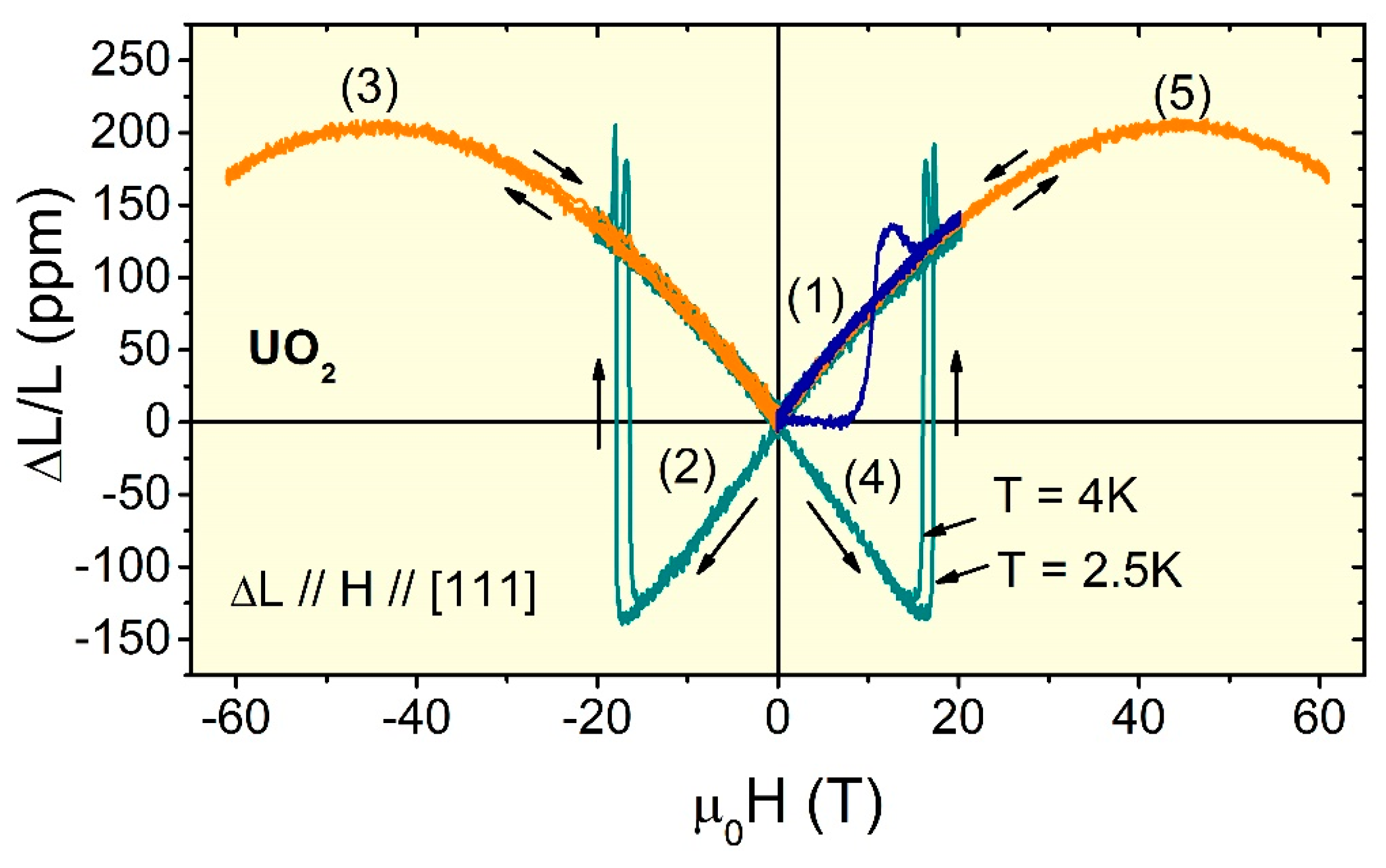
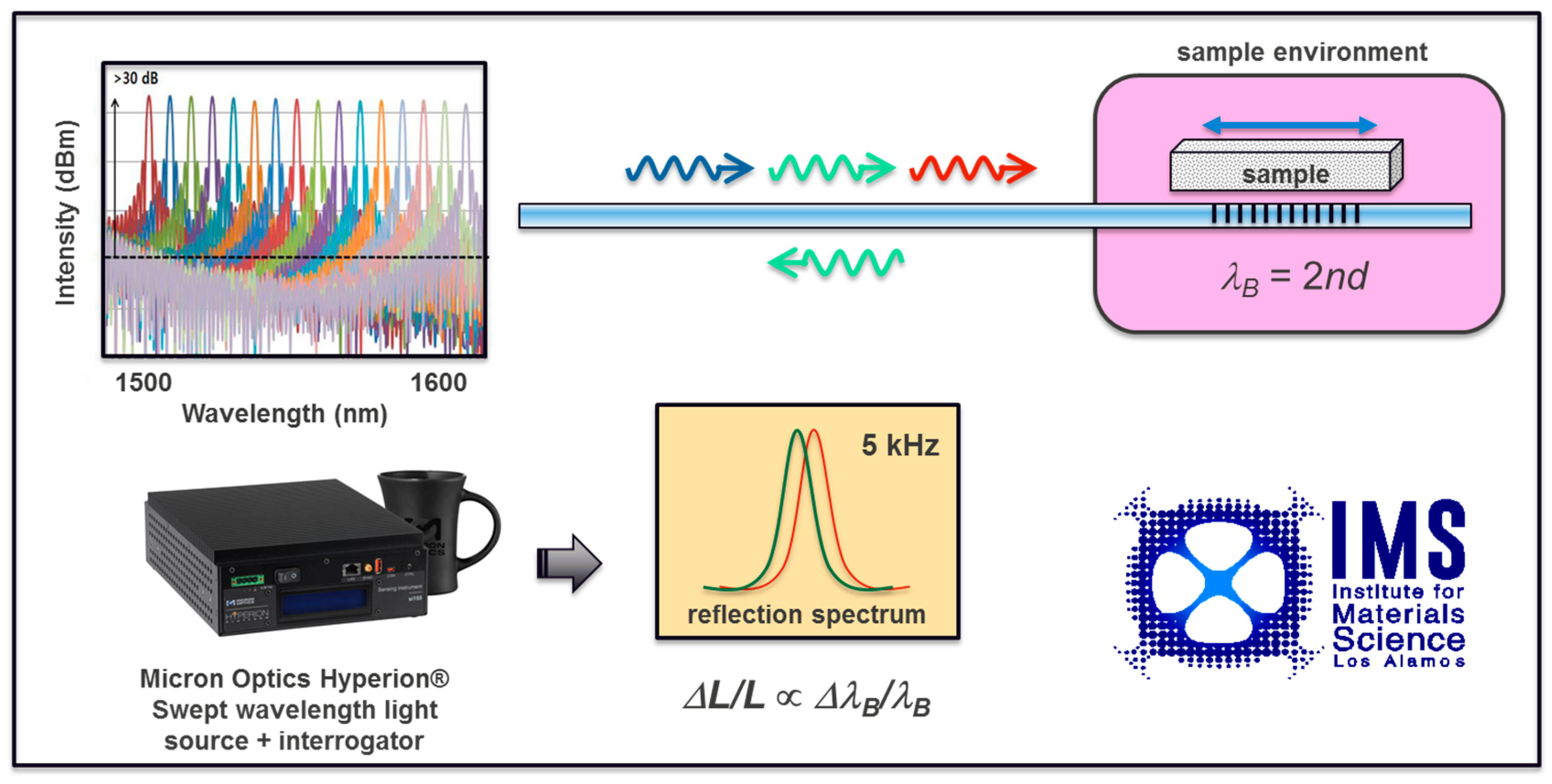
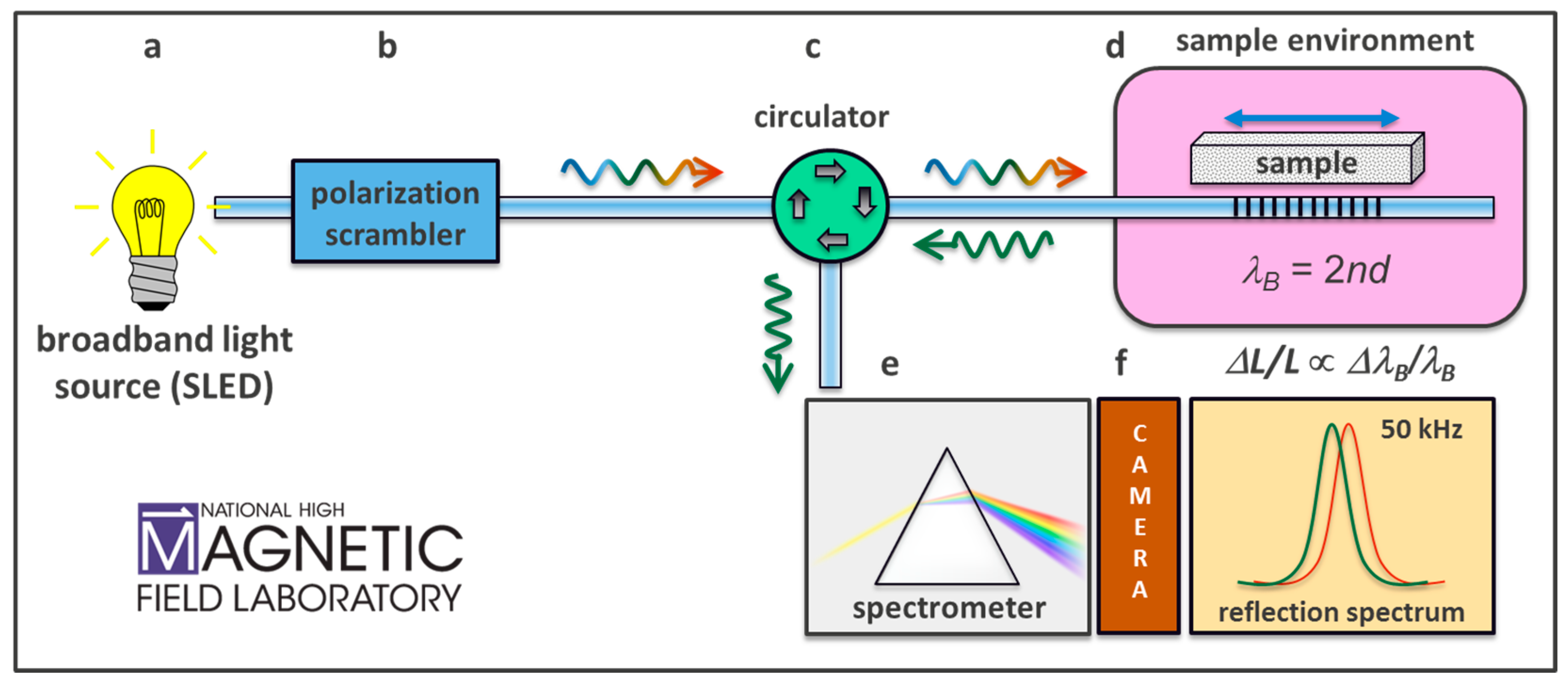
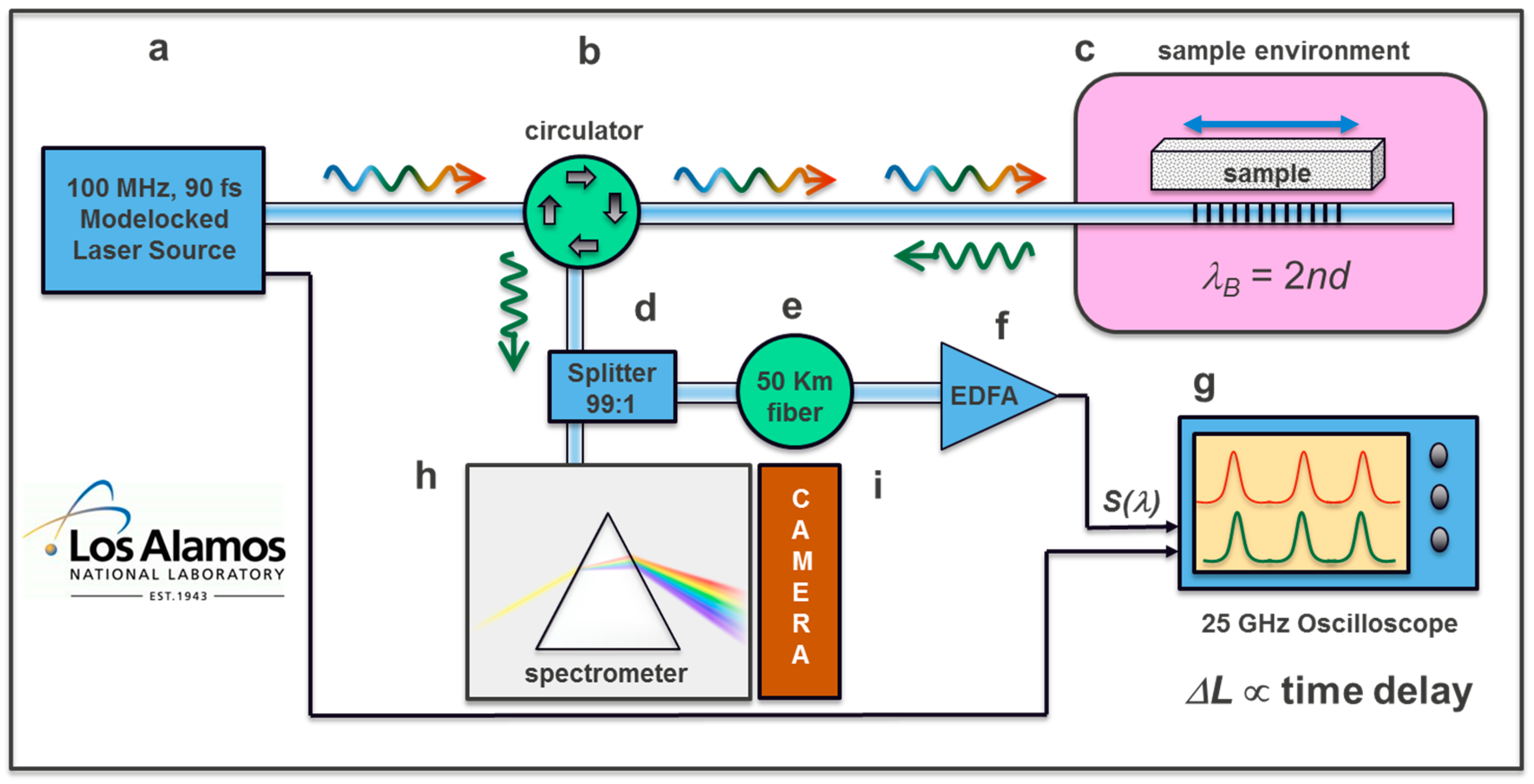

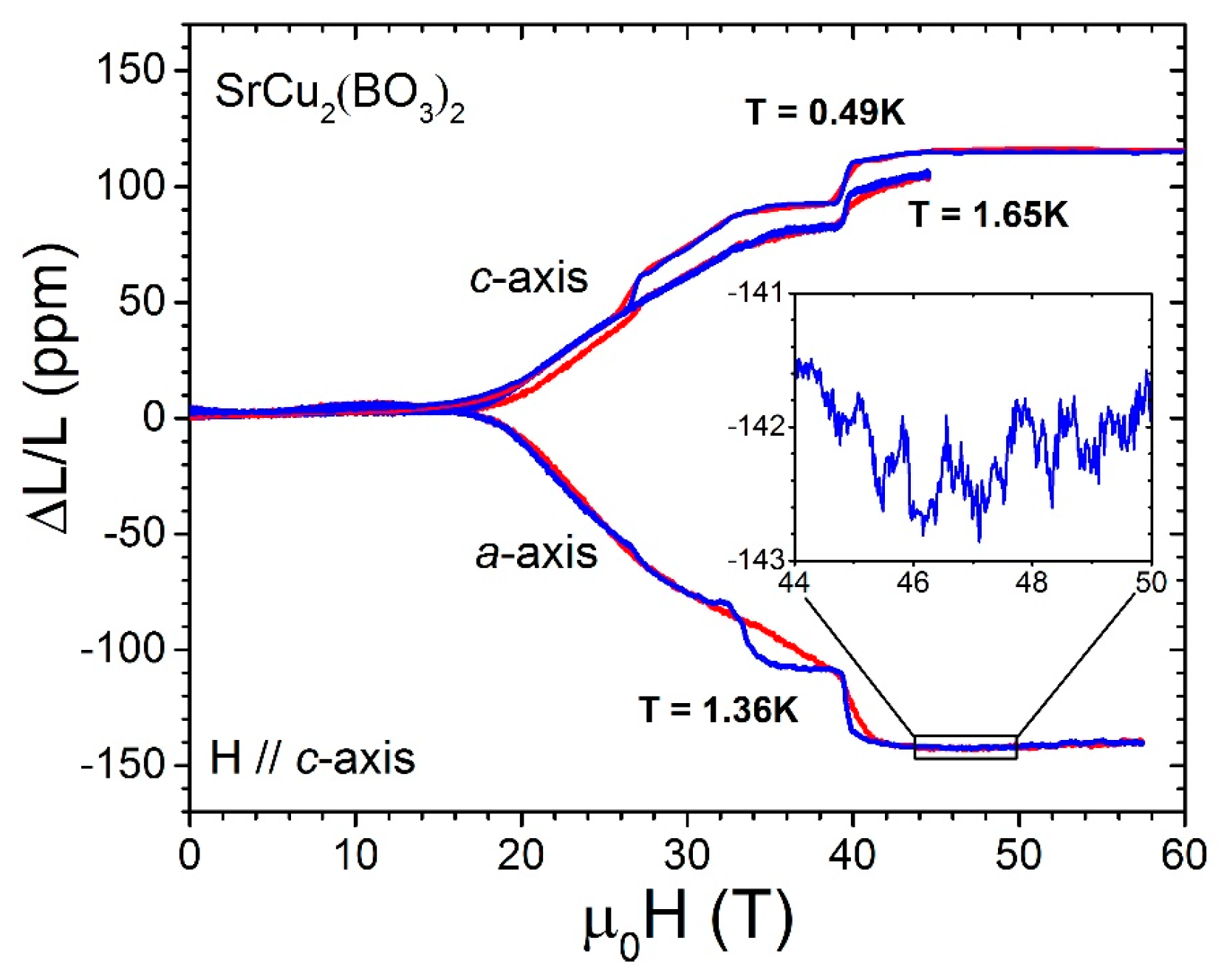
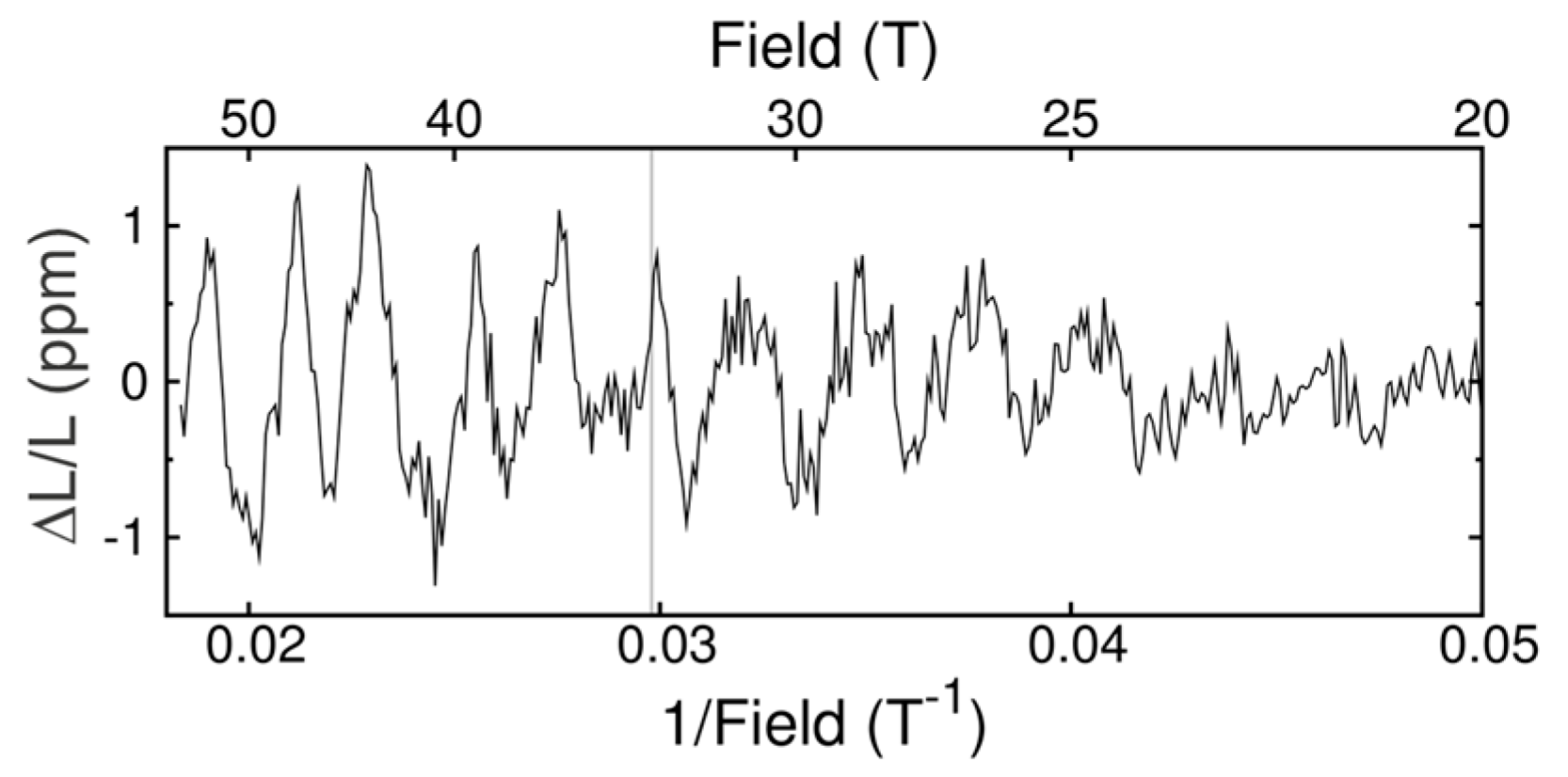
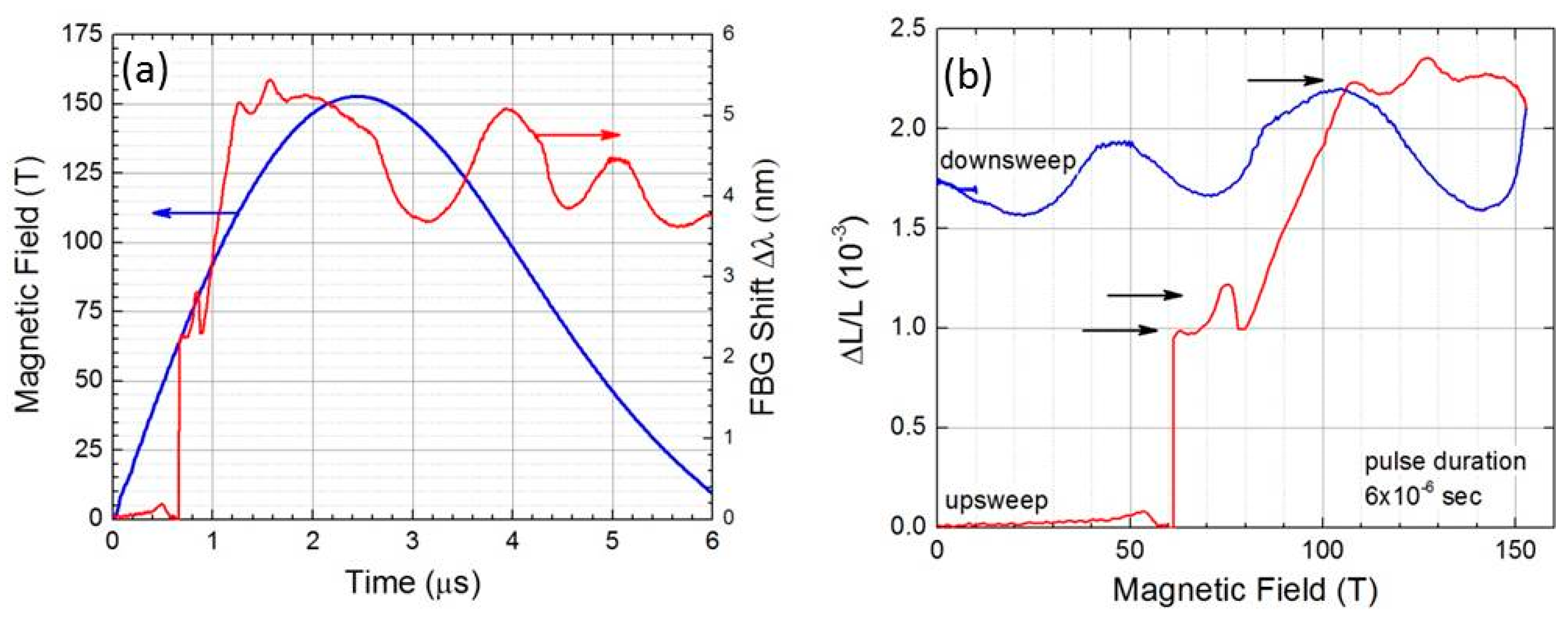
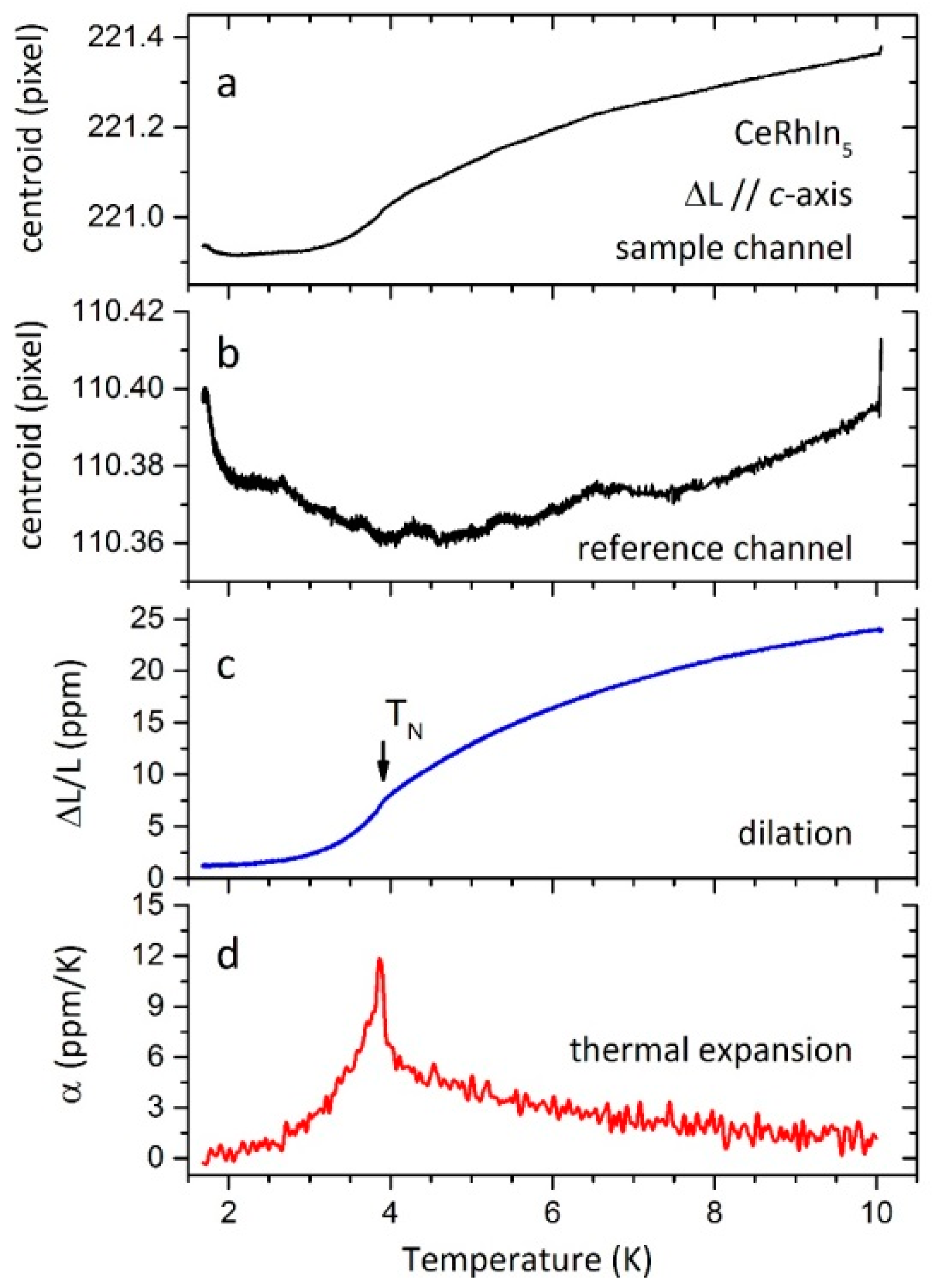
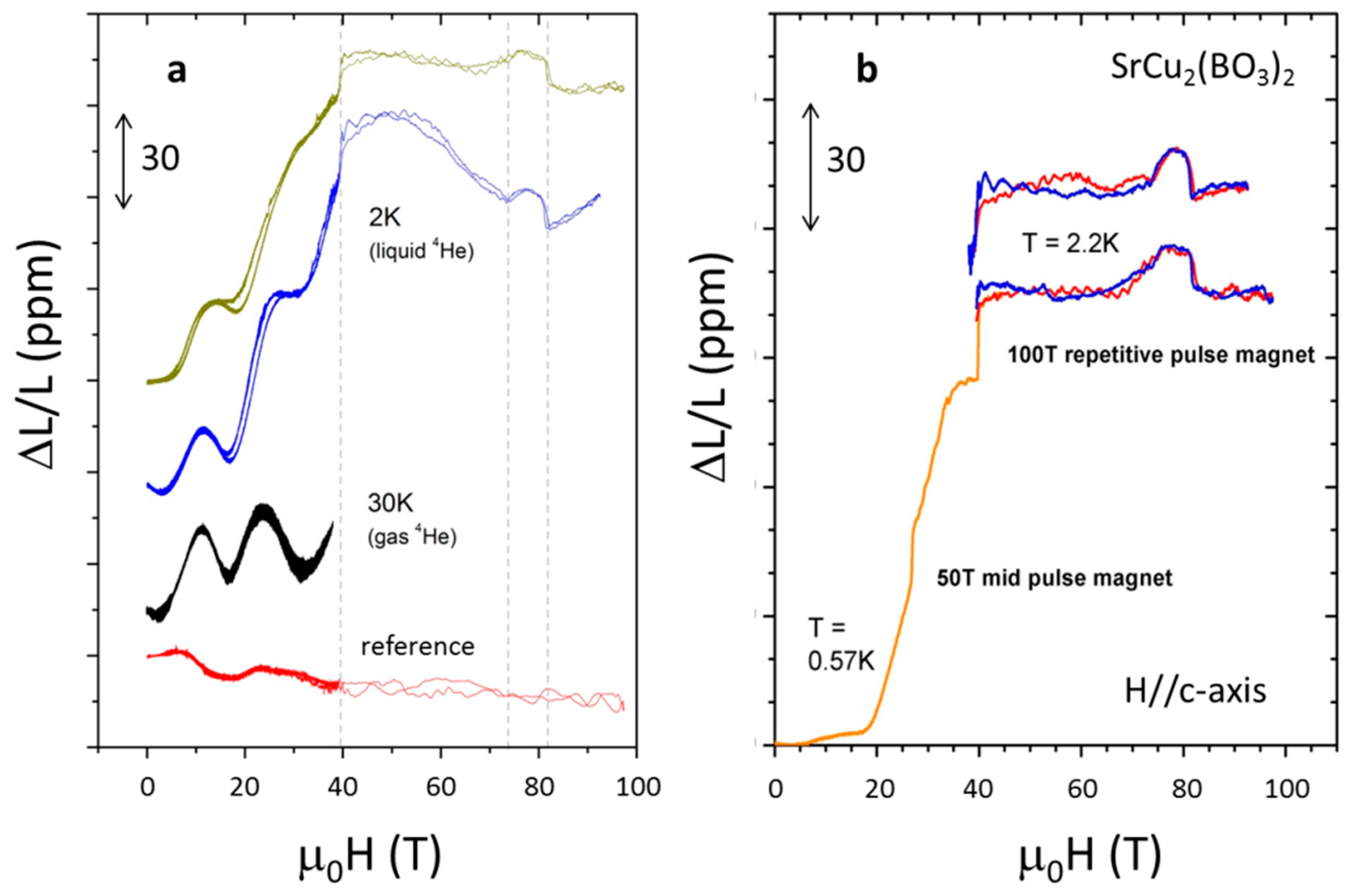
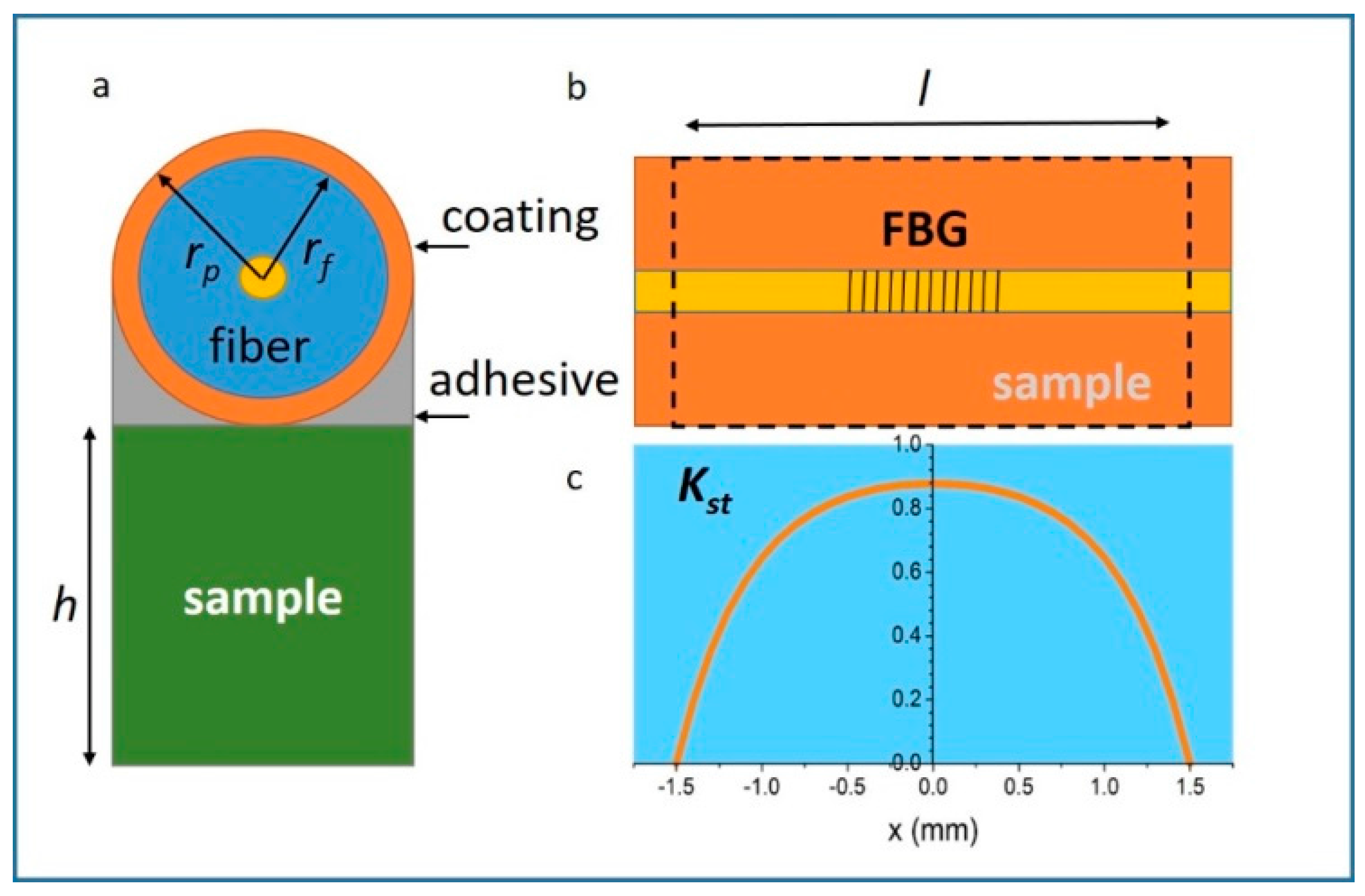
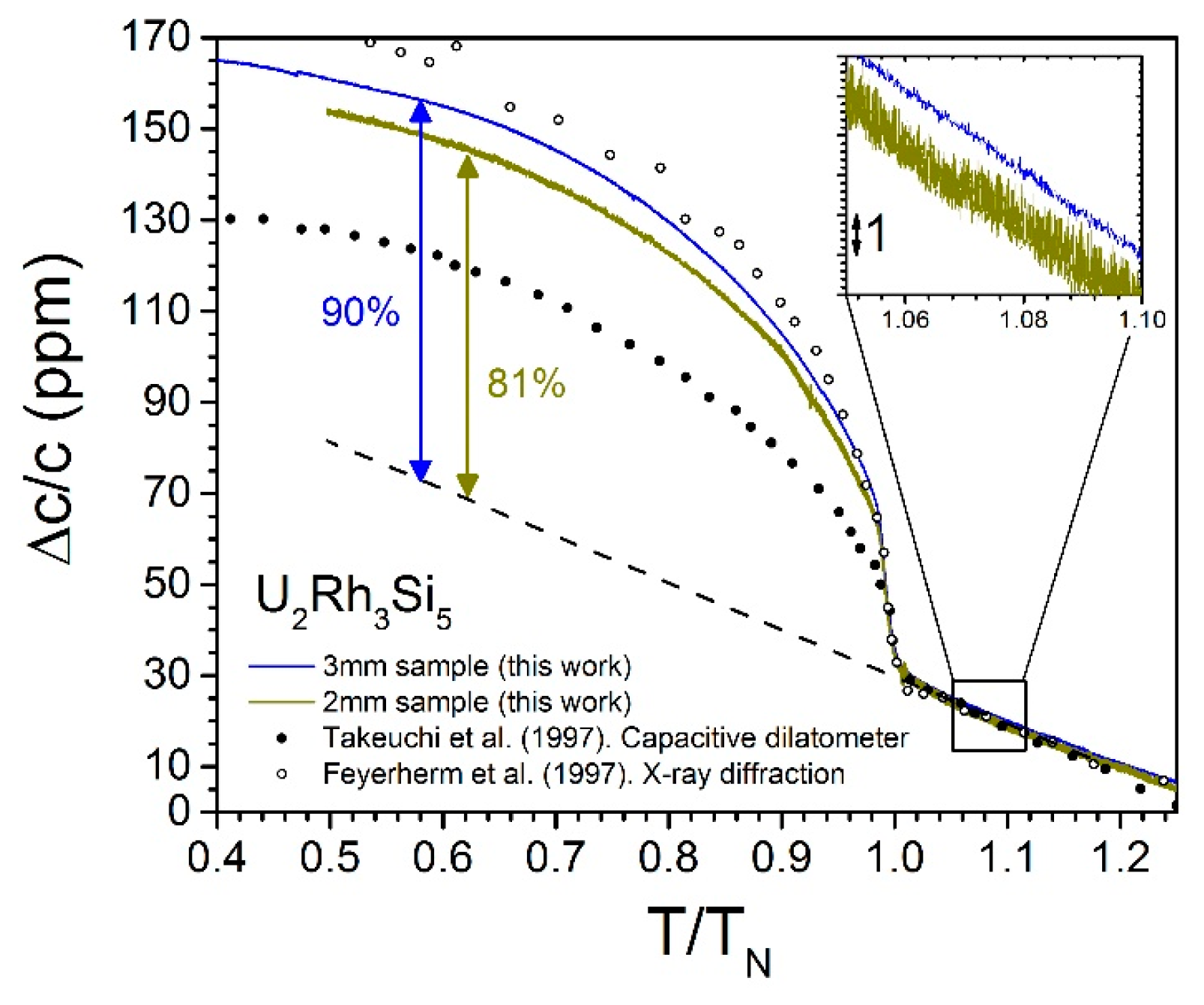

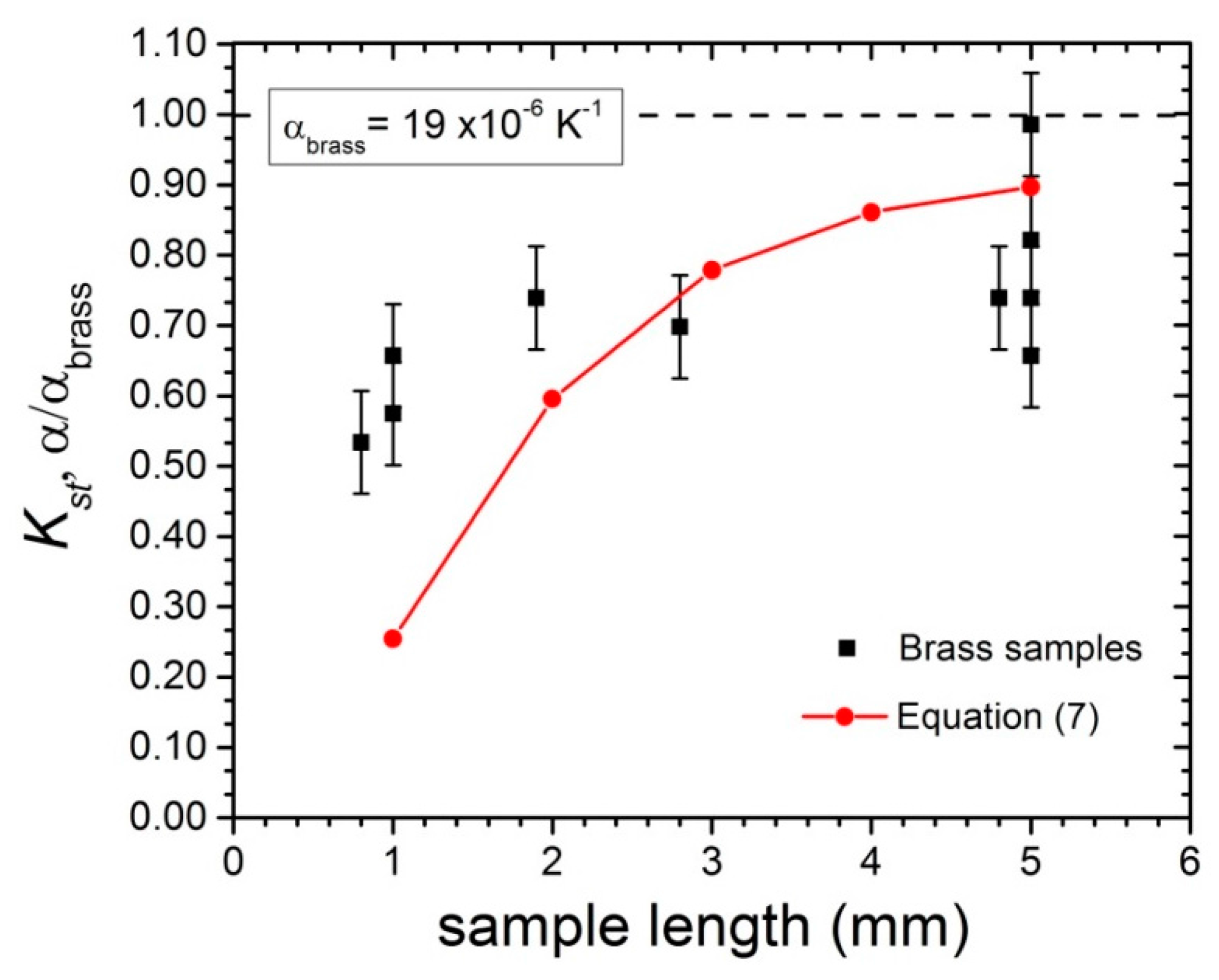
| Description | Symbol | Value |
|---|---|---|
| Sample elastic modulus | Es | 100 GPa |
| Fiber elastic modulus | Ef | 70 GPa |
| Polyimide coating shear modulus | Gp | 8 Gpa * |
| Acrylate adhesive shear modulus | Ga | 50 Mpa * |
| Sample length | l | 3 mm |
| Sample thickness | h | 0.5 mm |
| Fiber radius | rf | 62.5 μm |
| Coating radius | rp | 75 μm |
| Coefficient of strain transfer at FBG center | Kst | 0.902 |
© 2017 by the authors. Licensee MDPI, Basel, Switzerland. This article is an open access article distributed under the terms and conditions of the Creative Commons Attribution (CC BY) license (http://creativecommons.org/licenses/by/4.0/).
Share and Cite
Jaime, M.; Corvalán Moya, C.; Weickert, F.; Zapf, V.; Balakirev, F.F.; Wartenbe, M.; Rosa, P.F.S.; Betts, J.B.; Rodriguez, G.; Crooker, S.A.; et al. Fiber Bragg Grating Dilatometry in Extreme Magnetic Field and Cryogenic Conditions. Sensors 2017, 17, 2572. https://doi.org/10.3390/s17112572
Jaime M, Corvalán Moya C, Weickert F, Zapf V, Balakirev FF, Wartenbe M, Rosa PFS, Betts JB, Rodriguez G, Crooker SA, et al. Fiber Bragg Grating Dilatometry in Extreme Magnetic Field and Cryogenic Conditions. Sensors. 2017; 17(11):2572. https://doi.org/10.3390/s17112572
Chicago/Turabian StyleJaime, Marcelo, Carolina Corvalán Moya, Franziska Weickert, Vivien Zapf, Fedor F. Balakirev, Mark Wartenbe, Priscila F. S. Rosa, Jonathan B. Betts, George Rodriguez, Scott A. Crooker, and et al. 2017. "Fiber Bragg Grating Dilatometry in Extreme Magnetic Field and Cryogenic Conditions" Sensors 17, no. 11: 2572. https://doi.org/10.3390/s17112572
APA StyleJaime, M., Corvalán Moya, C., Weickert, F., Zapf, V., Balakirev, F. F., Wartenbe, M., Rosa, P. F. S., Betts, J. B., Rodriguez, G., Crooker, S. A., & Daou, R. (2017). Fiber Bragg Grating Dilatometry in Extreme Magnetic Field and Cryogenic Conditions. Sensors, 17(11), 2572. https://doi.org/10.3390/s17112572






